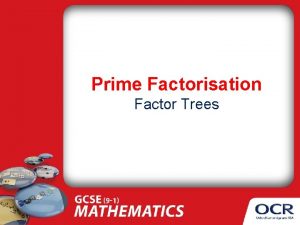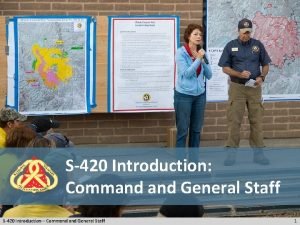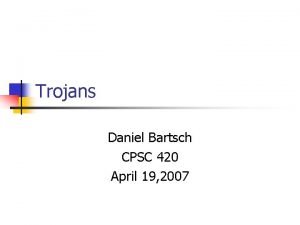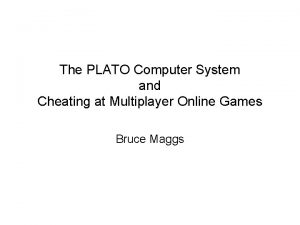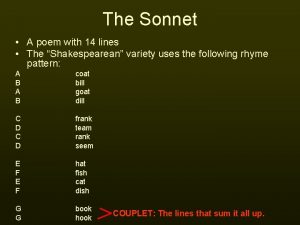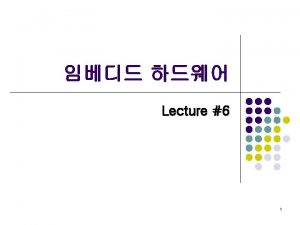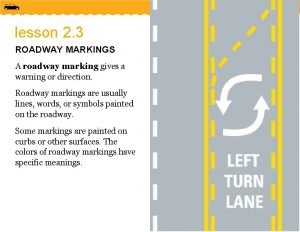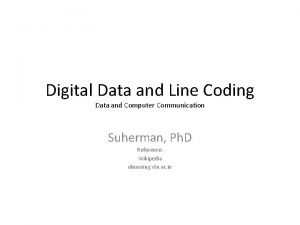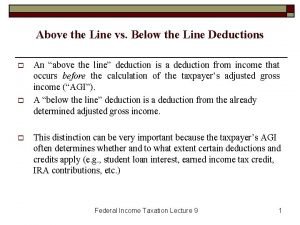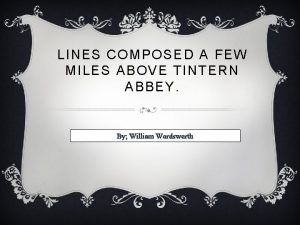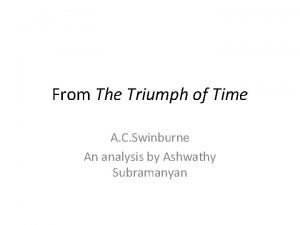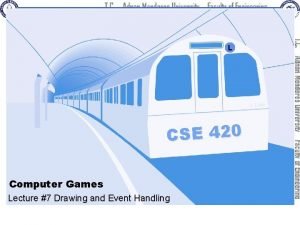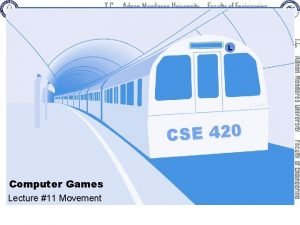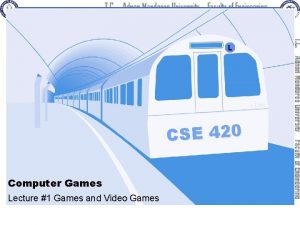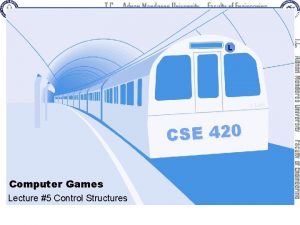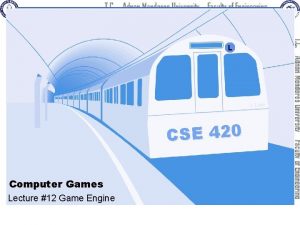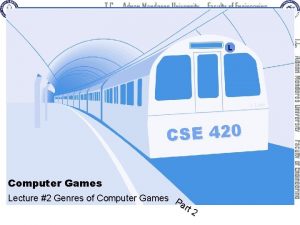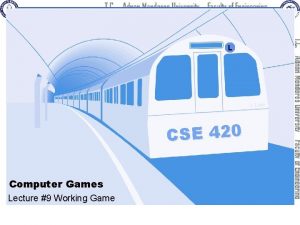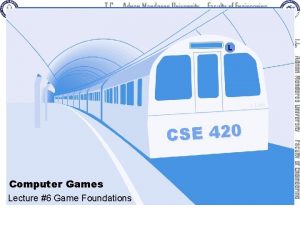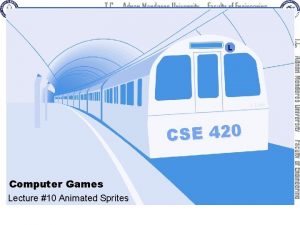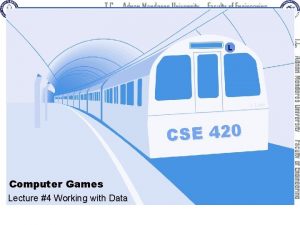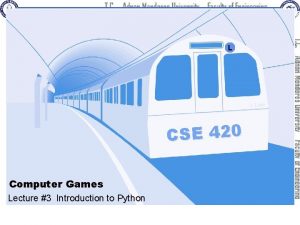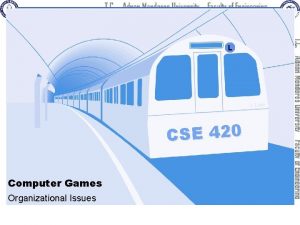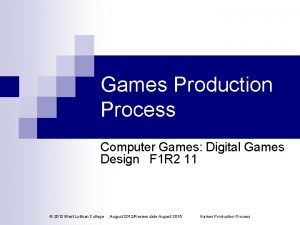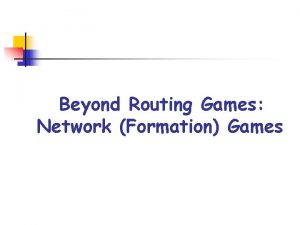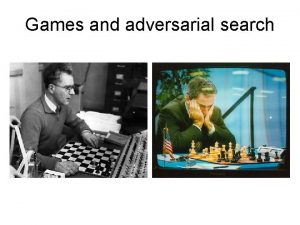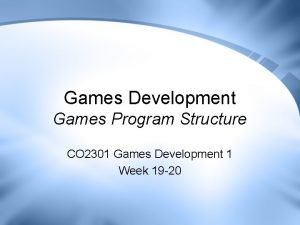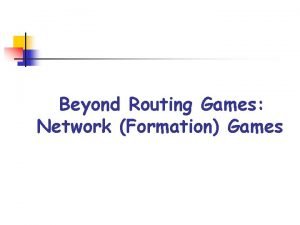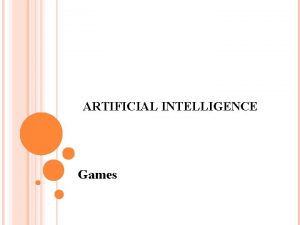L L Line CSE 420 Computer Games Lecture




























































































- Slides: 92

L L Line CSE 420 Computer Games Lecture #2 Genres of Computer Games P art 1

Objectives n n Identify the qualities that set action games apart from other genres Recognize the distinct subgenres of action games and their particular features Use the characteristic features of action games, such as levels, lives, and powerups, to design games of your own Know the design limitations imposed by placing the player under time pressure Lecture #2 Genres of Comp. Games 2

Objectives (Cont. ) n n n Know the definition of a strategy game and be familiar with the types of challenges that strategy games offer Define the set of orders that a strategy player will be able to give in your game Design a balanced set of units for use in a war game, including defining the attributes that govern their behavior Lecture #2 Genres of Comp. Games 3

Objectives (Cont. ) n n n Compute the relative values of offensive and defensive units Understand Lanchester’s laws and how they affect the relative strengths of forces of different size Create a technology tree of upgrades for the units that you have designed Lecture #2 Genres of Comp. Games 4

Objectives (Cont. ) n n Choose a system of logistics for your game and design the mechanism by which it works Know the most common types of artificial opponents and their strengths and weaknesses Lecture #2 Genres of Comp. Games 5

Objectives (Cont. ) n n n Know the definition of role-playing games and the game mechanics common to them Understand the history and evolution of roleplaying games from tabletop to computer Design character attributes for a role-playing game Lecture #2 Genres of Comp. Games 6

Objectives (Cont. ) n n n Define a world and setting suitable for a roleplaying game Understand the use of experience points and character level for this genre Know the different gameplay modes within this genre Lecture #2 Genres of Comp. Games 7

Objectives (Cont. ) n Know the definition of athletic sports games and be familiar with the types of challenges that these types of sports games offer n Understand the challenges of meeting players’ expectations about a real-world game in a video game implementation Lecture #2 Genres of Comp. Games 8

Objectives (Cont. ) n n n Know the basics of adapting a physical sports game mechanic to a virtual world Understand the design complexities for physics, AI, and player skill ratings required for a sports game Use flowcharting to help define AI states within a sports game Lecture #2 Genres of Comp. Games 9

Objectives (Cont. ) n Know the issues involved in licensing sports organizations, teams, and players, including the use of names and images n Understand mapping known physical game play mechanics to computer-human interface devices Lecture #2 Genres of Comp. Games 10 10

What Are Action Games? n n n An action game is one in which the majority of challenges presented are tests of the player’s physical skills Puzzle-solving, tactical conflict, and exploration challenges are often present as well Fastest action games are called twitch games Lecture #2 Genres of Comp. Games 11

Action Game Subgenres n Shooters q q q Most familiar and popular subgenre Players use a ranged weapon 2 D shooters n n Top-down or side-view perspective Players are under constant attack so shoot everything Unlimited ammunition Unrealistic physics Lecture #2 Genres of Comp. Games 12

Action Game Subgenres (Cont. ) n Shooters (cont. ) q 3 D shooters n n Cutting edge of game hardware Physics are more realistic than 2 D shooters Can be first-person or third-person perspective Further subgenres: q q Rail-shooters Tactical shooters Survival horror Arena games Lecture #2 Genres of Comp. Games 13

Action Game Subgenres (Cont. ) n Platform games q q q Cartoonish games in which an avatar moves through a vertically exaggerated environment, jumping on and off platforms Most actions are jumps Highly unrealistic physics Most 2 D side-scrolling games with humanoid avatar are platform games Super Mario Bros. is the classic example Lecture #2 Genres of Comp. Games 14

Action Game Subgenres (Cont. ) n Fighting games q q Physical challenges test reaction time and timing Simulate hand-to-hand combat n n n q q q May use a few ranged weapons Two major categories: one-on-one and mêlée. Serious boxing games usually classed as sports games Actions include maneuvering, attacking, and defending Combo moves are common Play is largely 2 D in the plane of the video screen Lecture #2 Genres of Comp. Games 15

Action Game Subgenres (Cont. ) n Fast puzzle games q q q Require player to solve problems quickly Simple, abstract, limited control set Tetris is the archetypal fast puzzle game Casual gamers enjoy this subgenre Ideal for handheld devices and cell phones Lecture #2 Genres of Comp. Games 16

Action Game Subgenres (Cont. ) n Action-adventure q q n Hybrid combines action and adventure Games include physical challenge, story, inventory, and dialog Dance and rhythm games q q Challenges player’s sense of rhythm Press buttons to make the avatar dance n q Specialized hardware common: dance mat, conga drums, maracas Popular with girls—less pointless violence Lecture #2 Genres of Comp. Games 17

Action Game Subgenres (Cont. ) n Other action games q q No shooting, hand-to-hand fighting, or abstract puzzle-solving Use skills such as maneuvering and path planning Lecture #2 Genres of Comp. Games 18

Game Features n Progression q Levels usually completed in linear sequence n n q q Levels often grouped by theme and end with a boss Fixed challenges are easier to build, but repetitious If killed, avatars reappear at a checkpoint Level exits, level warps, and teleporters n n n Level exits lead to the next level Level warps exit the level and jump ahead several levels Teleporter jumps within the same level Lecture #2 Genres of Comp. Games 19

Game Features (Cont. ) Planning your pacing: n 1. 2. 3. 4. 5. 6. 7. 8. 9. Brainstorm ideas for moments of excitement Order ideas by priority Create a story framework Rate key events for intensity, and sequence them Rate and sequence story plot points Set the time between high-intensity events Evaluate the trends Begin constructing levels Iteratively test, review, and adjust Lecture #2 Genres of Comp. Games 20

Game Features (Cont. ) n Challenges q Avatars typically faced by three kinds of problems n n n Passive obstacle impedes movement without threat (wall) Stationary danger attacks approaching avatar (electric fence) Active dangers attack and move around Lecture #2 Genres of Comp. Games 21

Game Features (Cont. ) n Challenges (cont. ) q q q Waves—enemies attack in groups The big boss guards the end of themed level Wildcard enemies break up the predictability Locked doors partition levels and control progress Monster generators or spawn points cause new enemies to appear Lecture #2 Genres of Comp. Games 22

Game Features (Cont. ) n Player actions q q q Routine actions include maneuvering an avatar, aiming and shooting, collecting and selecting, manipulating objects, and fighting moves Smart bomb clears enemies from the immediate area Hyperspace escape immediately moves the player at the risk of unexpectedly entering a dangerous area Lecture #2 Genres of Comp. Games 23

Game Features (Cont. ) n Core mechanics are simple and obvious q q Lives provide several reprieves from death Energy is replenished by collectibles or powerups Powerups increase strength Collectibles are common but not required n n Increase the score Unlock secret levels or cause special bonus events Lecture #2 Genres of Comp. Games 24

Game Features (Cont. ) n Core mechanics (cont. ) q q Timer counts down time to events and catastrophes or the amount of time left to finish the level Score indicates progress Lecture #2 Genres of Comp. Games 25

Game Features (Cont. ) n Victory conditions q q n Only arcade (or arcade-like) games don’t have victory conditions Including a structured story means the game will end Interaction model q q Avatar is most common Puzzle manipulation model (Tetris) or omnipresent model (Lemmings) also used Lecture #2 Genres of Comp. Games 26

Game Features (Cont. ) n Camera models q 2 D camera models n n q q 3 D first person is tied to the avatar with a limited field of view 3 D third person lets the player see the avatar n q Includes side-scrolling and top-scrolling perspectives Continuous, variable, and parallax scrolling Many offer both, switchable at player option Resident Evil 4 combines these somewhat, moving camera to just behind avatar’s shoulder Lecture #2 Genres of Comp. Games 27

Game Features (Cont. ) n Camera models (cont. ) q Gameplay implications of 2 D and 3 D n n n q In 3 D, it is difficult to tell the speed or distance of objects that come directly toward the player 3 D games use the environment to present challenges In 3 D, enemies can hide and sneak up on the avatar Context-sensitive models n n Camera moves depending on the circumstances Not a good model for fast action games q Sudden changes of camera position are disorienting during high-speed action Lecture #2 Genres of Comp. Games 28

Game Features (Cont. ) n User interface features q q q q Display only as much as the player needs to know Keep it onscreen Use indicators rather than numbers or text Draw attention to critical information Maps and mini-maps can be shown as transparent overlays; keep them simple Use color to identify characters and objects Controls should be as simple as possible Lecture #2 Genres of Comp. Games 29

What Are Strategy Games? n n The majority of challenges are strategic conflict Player chooses from a variety of potential actions or moves at most points in the game Victory is attained by superior planning and taking the best actions; chance must not play a large role Other challenges may also be present; physical challenges play little or no part Lecture #2 Genres of Comp. Games 30

Game Features n Two main subgenres q Classical turn-based games n n q Pure strategy games tend to be turn-based In multiplayer turn-based computer games, players often choose their next move simultaneously Real-time strategy games n n Developed after turn-based games RTSs add time pressure to strategy games Lecture #2 Genres of Comp. Games 31

Game Features (Cont. ) n Challenges q Strategic conflict n n n q Conflict is combat between groups of units Factories generate more units Players can choose from among a variety of units Diplomacy and espionage offer alternatives to combat Lecture #2 Genres of Comp. Games 32

Game Features (Cont. ) n Challenges (cont. ) q Exploration challenges n n q Allow players to investigate unknown territory Fog of war—unexplored areas shown in black, and explored but unpatrolled regions shown dimly Economic challenges n n Players can collect resources to buy units If the economy is complicated, the game is actually a hybrid of a strategy game and a construction and management game, e. g. the Civilization series Lecture #2 Genres of Comp. Games 33

Game Features (Cont. ) n Player actions involve giving orders to units q q q q Move to a location Attack Stop moving Hold a position Establish a formation Produce new units Retreat, dash, and patrol are variants of these Lecture #2 Genres of Comp. Games 34

Core Mechanics n Designing units q q q Units usually fall into types so that all units of a type share a set of attributes Some units will also have special unique capabilities Rock-paper-scissors (RPS) model is suited only to simple games n n Cannot be balanced for complex game Doesn’t take into account battlefield conditions Lecture #2 Genres of Comp. Games 35

Core Mechanics (Cont. ) n Designing units (cont. ) q q Modern war games use numeric attributes to describe unit’s abilities Numeric attributes used more often are: n n n Health Weapons Range Shot mass and velocity (or power) Accuracy n n n Lecture #2 Genres of Comp. Games Defensive dodging Speed Turn rate Mass and acceleration Range of vision 36

Core Mechanics (Cont. ) n Designing units (cont. ) q Special capabilities include: n n n n Stealth Flying or sailing Repair Transport Constructing buildings and production of mobile units Leadership For every special capability you create for one side, you must also create a capability of similar military value for the other side OR a way to defeat the special capability Lecture #2 Genres of Comp. Games 37

Core Mechanics (Cont. ) n Designing units (cont. ) q Computing the relative value of units n n n Value based on time and resources Equation for attack units: Attack unit value = maximum health shot power rate of fire theoretical accuracy range maximum speed Equation for defensive units: Defense unit value = maximum health shot power rate of fire theoretical accuracy (range 2 ÷ 2) Lecture #2 Genres of Comp. Games 38

Core Mechanics (Cont. ) n Designing units (cont. ) q Production rates, unit numbers, and Lanchester’s laws n n Lanchester’s Linear Law: In hand-to-hand combat, the relative strengths of two armies are simply proportional to their numbers of troops Lanchester’s Square Law: For units that can aim and shoot at one another from a distance and can concentrate their fire, the strength differential is proportional to the square of their sizes Lecture #2 Genres of Comp. Games 39

Core Mechanics (Cont. ) n Health, morale, and fighting efficiency q Units normally fight at full efficiency until their health points are gone n q Morale is represented by a number that increases or decreases an army’s fighting effectiveness n q If you allow efficiency to be harmed by poor health, the feedback loop will cause injured units to die very quickly Morale also usually produces too much feedback Leadership bonus works better, because leadership is unaffected by health or morale. Lecture #2 Genres of Comp. Games 40

Core Mechanics (Cont. ) n Upgrades and technology trees q Researching upgrades n n n q q q Player must initiate research Organize upgrades into a sequence Allow player to choose which upgrade to research Upgrades can be applied to single units, unit types, or globally Upgrades can be temporary or permanent Create a technology tree to organize large numbers of upgrades Lecture #2 Genres of Comp. Games 41

Core Mechanics (Cont. ) n Logistics q q q Management of supply: the production, distribution, maintenance, and replacement of personnel and materials Strategy games usually have simplified logistics Supplies and consumable items n n n Don’t track food and fuel If ammo is cheap and quickly expended, provide unlimited supply Highly destructive ammo should be rare and tracked Lecture #2 Genres of Comp. Games 42

Core Mechanics (Cont. ) n Logistics (cont. ) q Supply lines n n n Route over which fresh troops and war materiel must be transported from their source to where they are needed Cutting the supply line is a classic strategy Most computer war games model movement of troops accurately, but not materiel such as fuel and ammo q q Players don’t want to manage supplies Realistic supply lines mean creating transport units and modeling the supplies as individual objects Lecture #2 Genres of Comp. Games 43

Core Mechanics (Cont. ) n Logistics (cont. ) q Abstracting the distribution process n n n q A supply is “magically” available wherever it is needed Completely abstracting distribution cause exploits Alternative is verifying that supply routes are open, but don’t actually require transport Road-building n n n Build roads to access resources Roads provide supply routes Towns with no road cannot receive supplies Lecture #2 Genres of Comp. Games 44

Core Mechanics (Cont. ) n Logistics (cont. ) q Influence maps n n Any unit within a certain distance from a supply depot can receive supplies Unobstructed route not required Lecture #2 Genres of Comp. Games 45

The Game World n Historical settings q q Military strategy games tend to be set in the past Historical setting will be scrutinized for accuracy by players familiar with the event World War II market oversaturated Need a less popular time period or unique approach Lecture #2 Genres of Comp. Games 46

The Game World (Cont. ) n Modern settings q q Risks generating controversy and negative public opinion Must be rigorously accurate and politically neutral n q Some use modern, but fictitious, settings to avoid this Must address the issue of battlefield scale n n A battlefield scaled for fighter planes would take weeks for infantry to walk across. One solution is to exclude units that don’t fit the scale, i. e. leave infantry out of games about fighter planes Lecture #2 Genres of Comp. Games 47

The Game World (Cont. ) n Future (science fiction) settings q q q Popular and allow a lot of scope for invention Might not catch public’s imagination Use technology carefully Define terminology Must address the issue of battlefield scale again Lecture #2 Genres of Comp. Games 48

The Game World (Cont. ) n Fantasy settings q q Use magic rather than technology More emphasis on close-range and hand-to-hand combat Lecture #2 Genres of Comp. Games 49

The Presentation Layer n Interaction model q q q n Almost always multipresent Large scale—player indirectly controls units and has godlike view of the game world Squad scale—smaller group of 20 individual units Camera model q q Players need to see the big picture Aerial perspective needed Lecture #2 Genres of Comp. Games 50

The Presentation Layer (Cont. ) n User interface q q q Player must control action at different scales Usually present related data in separate windows Make unavailable options gray Provide beginner and advanced modes for commands Group commands by function Lecture #2 Genres of Comp. Games 51

Artificial Opponents n Game tree search q q n Game tree is the set of all possible future moves This approach works for only the simplest games Neural net q q Mimics the brain’s ability to recognize and correctly identify patterns of data Not currently used in consumer games Lecture #2 Genres of Comp. Games 52

Artificial Opponents (Cont. ) n Hierarchical finite state machines q q Most successful mechanism for creating AI opponents in war games What is a finite state machine? n n n Conceptual machine, not real mechanical engineering Its rules establish a simple behavioral system for an individual automated character Each unit has a set of states that it can be in In each state it continously executes certain behaviors Each state has a list of events or conditions that cause it to switch to a new state, e. g. guarding to attacking Lecture #2 Genres of Comp. Games 53

Artificial Opponents (Cont. ) n Hierarchical finite state machines (cont. ) q Hierarchical finite state machines in games n n Ones higher up in the hierarchy give orders to the ones lower down Higher FSMs can order lower FSMs to change state AI alone usually can’t beat a human player except in simple games Most AI opponents get other advantages q q Human doesn’t know where his enemy is Designer gives AI more resources to start with Lecture #2 Genres of Comp. Games 54

What Are Role-Playing Games? n Overview q q Objective is to experience a series of adventures in an imaginary world, through an avatar or a small group of characters whose skills and powers grow over time Essential parts are the quest or story and character growth Victory consists of completing the quests Many players just enjoy exploring and interacting, even without trying to win Lecture #2 Genres of Comp. Games 55

What Are Role-Playing Games? (Cont. ) n Many types of challenges: q q q Tactical combat Logistics (managing supplies) Economic growth Exploration Puzzle solving Lecture #2 Genres of Comp. Games 56

Comparisons to Other Genres n CRPGs and war games q q q Both include combat governed by rules CRPGs—small group of characters who exhibit growth; no factories to produce more units War games—large group of identical units; factories produce more units Lecture #2 Genres of Comp. Games 57

Comparisons to Other Genres (Cont. ) n CRPGs and action games q CRPGs n n n q Physical challenges becoming more common in hybrids Non–action-related activities such as buying and selling as well as conversations with other characters Puzzles more sophisticated than in action games Action games n n Physical challenges Non–action-related activities are rare Lecture #2 Genres of Comp. Games 58

Comparisons to Other Genres (Cont. ) n CRPGs and adventure games q q q Both have rich storylines, highly detailed characters, and exploration challenges CRPGs—player-defined character; characters defined by numeric attributes that improve over time; complex internal economy Adventure games—avatar provided by the game; concentrate on a single character; puzzle challenges; no numeric attributes; personal growth; simple internal economy (or none at all) Lecture #2 Genres of Comp. Games 59

Game Features n n Exploration and combat make up a big part of most CRPGs Themes q q n Saving the world is an overused theme Try to find an alternative approach Progression q q q Long quest broken into episodes Major challenge at the end of each episode Optional side quests Lecture #2 Genres of Comp. Games 60

Game Features (Cont. ) n Gameplay modes q q Exploration and combat—actions include setting a destination, designating an NPC to attack, and using special skills Conversation—uses dialog tree Trade—buy and sell items Inventory—manage carried objects Lecture #2 Genres of Comp. Games 61

Core Mechanics n n Rolling dice—know the probabilities to get the result you want Character attributes q Characterization attributes—determine general abilities and qualities; change infrequently n n Race Sex Character class Physical, mental, moral, and social attributes Lecture #2 Genres of Comp. Games 62

Core Mechanics (Cont. ) n Character attributes (cont. ) q Status attributes, experience, and character levels n n q Attributes that change frequently Experience points and character level measure the character’s growth Cosmetic attributes add richness to the game Lecture #2 Genres of Comp. Games 63

Core Mechanics (Cont. ) n Magic and its equivalents q Concept that allows characters to influence the world by means not available to us in real life n q q Science fiction implements magic as “advanced technology” Use of magic restricted by character class Define magic, how it’s invoked, how it’s limited Player can often spend magic points, called mana The mana system is more convenient and flexible than the D&D “memorization” system Lecture #2 Genres of Comp. Games 64

Core Mechanics (Cont. ) n Skills and special capabilities q q n Obtaining new skills for a character is similar to upgrading a unit in a strategy game Skill trees provide a growth path similar to a tech tree in war games Character design q q Most CRPGs allow the player to create the character Roll dice to generate points to distribute among character attributes Lecture #2 Genres of Comp. Games 65

The Game World and Story n Settings q q q Tend to be fantasy and science fiction settings Must be appealing to explore Some CRPGs provide an editor to enable players to create scripted adventures in the game world Lecture #2 Genres of Comp. Games 66

The Game World and Story (Cont. ) n Story q q First, determine the game’s overall quest—the ending Then, design the episodes that the player experiences from the beginning to the end Add side quests Write an enticing opening Lecture #2 Genres of Comp. Games 67

The Presentation Layer n Interaction model q Party-based in single-player CRPG n q n Avatar-based is becoming more common, however Avatar-based in multiplayer online games Camera model q q First person or third person for avatar-based models Aerial perspective allows player to see all members of the party at once as well as surrounding terrain Lecture #2 Genres of Comp. Games 68

The Presentation Layer (Cont. ) n User interface q q q Wide range of actions—interface can be complex Hide the mechanics to aid the player’s immersion Repetitive tasks—instead of making the player try repeatedly, automate the repetition and show a progress bar n n If the character has low skill at the task, it will take a long time Allow the player to interrupt and abandon the attempt Lecture #2 Genres of Comp. Games 69

What Are Sports Games? n n n A sports game simulates some aspect of a real or imaginary athletic sport, whether it is playing in matches, managing a team or career, or both Match play makes use of physical and strategic challenges The management challenges are chiefly economic Lecture #2 Genres of Comp. Games 70

Game Features n Game structure q q q n Main gameplay mode is match play Outside of match play, game’s modes relate to other aspects of the sport Pause the game for coaching tasks Player roles q q Athlete is most common role—player follows the action rather than a single athlete in team sports Player may also take role of coach or manager Lecture #2 Genres of Comp. Games 71

Game Features (Cont. ) n Gameplay and rules q Challenges and actions match the sport n n q q Athlete—Physical challenges Coach—Strategic challenges Rules might have to be relaxed because controlling athletes onscreen does not correspond exactly to real-life sports experiences Need to decide what to do about athlete mistakes outside of player control n Allow players to set referee parameters Lecture #2 Genres of Comp. Games 72

Game Features (Cont. ) n Competition modes q q q All competition modes are allowed Sports games are more popular on consoles to permit multiplayer competition One mode should include computer versus itself so players can watch a match Lecture #2 Genres of Comp. Games 73

Game Features (Cont. ) n Victory and loss conditions q q Match real sport’s victory and loss conditions Modes n n n Season mode Exhibition mode Sudden death Round robin Tournament mode Franchise mode Lecture #2 Genres of Comp. Games 74

Game Features (Cont. ) n Opportunities for creative play q q q Team creation—players create their own teams Strategy design—players can create their own strategies Playing field design—players can edit the shape of the playing field if sport allows this option Lecture #2 Genres of Comp. Games 75

Game Features (Cont. ) n n Inventing a sport is a risky option that is hard to sell Weather q q n Weather can invoke special rules Weather affects the game Instant replay is an essential feature q q q Include all usual video forward/reverse features Allow player to move camera around Allow locking the camera to an athlete or the ball Lecture #2 Genres of Comp. Games 76

Core Mechanics n Physics for sports games q q Physics engine determines the behavior of moving bodies in the match Physics should not be perfectly realistic because n n Player does not have precise control Player is not a professional athlete Lecture #2 Genres of Comp. Games 77

Core Mechanics (Cont. ) n Rating the athletes q q Developing ratings is a big task Ratings provide data for the physics engine to simulate the athletes accurately Common ratings are provided for all athletes— speed, agility, weight, etc. Specialized ratings apply to specific positions— passing strength, passing accuracy, etc. Lecture #2 Genres of Comp. Games 78

Core Mechanics (Cont. ) n Athlete AI design q Define the state space n n q Play in a match is broken into states defined by rules and strategy (e. g. , fly ball, foul ball, grounder, strikeout) Create a flowchart to map the game’s states Set collective and individual goals in each state n n Individual goals are what each athlete tries to achieve in the course of playing his position Collective goal is what the team is trying to achieve as a whole; the collective goal determines individual goals Lecture #2 Genres of Comp. Games 79

Core Mechanics (Cont. ) n Injuries q q n Injuries introduce some chance Allow players to turn off injuries Arcade mode versus simulation mode q q Arcade mode increases action and decreases realism; produces higher scores Simulation mode increases realism but probably decreases action Lecture #2 Genres of Comp. Games 80

Core Mechanics (Cont. ) n Simulating matches automatically q q Computer plays out matches and records results To fake results quickly, roll dice to generate game scores n n q Scores must be restricted to a credible range Doesn’t generate other statistics Allowing a home field advantage is not recommended Lecture #2 Genres of Comp. Games 81

The Game World n Setting q q q Accurate copies of real stadiums and arenas Weather significantly affects games played outdoors Crowd noises contribute to setting Lecture #2 Genres of Comp. Games 82

The Game World (Cont. ) n Licenses, trademarks, and publicity rights q Team and league trademarks n n q In America, the league holds the license to use the team and league names, logos, uniform designs, etc. A variety of governing bodies manage individual sports Events are owned by the organization producing them Stadiums are now asserting trademark rights too Personal publicity rights owned by the athlete or an organization Lecture #2 Genres of Comp. Games 83

The Game World (Cont. ) n Audio commentary q q q Needed to feel like you’re watching the match on television Play-by-play and color commentary Note the events that should trigger a specific comment Lecture #2 Genres of Comp. Games 84

The Presentation Layer n Interaction model q q n Player usually controls an avatar Which athlete is being controlled can change as the play progresses (in team sports) Camera models q q Don’t use first-person; players watch the athletes Overhead—individual sports End view or side view—team sports Picture-in-picture—sports with more than one focal point, e. g. baseball or cricket Lecture #2 Genres of Comp. Games 85

The Presentation Layer (Cont. ) n User interface design q Input Devices n n q Motion-sensitive (e. g. Wii controller) best for sports In team games, let the player press a button to switch control to the most appropriate defending athlete Displays n n User interface can change every second, depending on conditions in the match Each state requires a set of options Mark the controlled athlete with a label Use overlays rather than pull-down menus Lecture #2 Genres of Comp. Games 86

Summary n You should now understand q q How to identify an action game How to recognize action game subgenres How to identify and use characteristics of an action game How to describe design limitations of action games Lecture #2 Genres of Comp. Games 87

Summary (Cont. ) n You should now understand q q q q How to identify a strategy game How to define the orders a player can give in your game How to design a balanced set of units How to use Lanchester’s laws in combat How to create a technology tree of upgrades How to enact logistics How to utilize artificial intelligence Lecture #2 Genres of Comp. Games 88

Summary (Cont. ) n You should now understand q q q How to identify a role-playing game How to describe the development of the roleplaying game from tabletop to computer How to design character attributes How to define a world and story How to use experience points and character levels How to define gameplay modes for RPGs Lecture #2 Genres of Comp. Games 89

Summary (Cont. ) n You should now understand q q q q How to identify a sports game How to describe the player’s expectations for a sports game How to adapt a sport for a video game How to rate players How to flowchart states in a match How to license teams and players How to create a user interface for a sports game Lecture #2 Genres of Comp. Games 90

Next Lecture Genres of Computer Games Part 2 91

References n 92 Ernest Adams, Fundamentals of Game Design, 2 nd Edition, New Riders, 2016
 01:640:244 lecture notes - lecture 15: plat, idah, farad
01:640:244 lecture notes - lecture 15: plat, idah, farad Hunger games chapter 7
Hunger games chapter 7 Outdoor games and indoor games
Outdoor games and indoor games Eg subject code
Eg subject code Computer security 161 cryptocurrency lecture
Computer security 161 cryptocurrency lecture Computer-aided drug design lecture notes
Computer-aided drug design lecture notes Computer architecture lecture notes
Computer architecture lecture notes Isa vs microarchitecture
Isa vs microarchitecture Mini metric olympics
Mini metric olympics Artigo 420 do codigo civil
Artigo 420 do codigo civil Csci 420
Csci 420 What does axaxaxa mean
What does axaxaxa mean Factor tree of 90
Factor tree of 90 Position vector define
Position vector define Doe order 420
Doe order 420 Enve420
Enve420 Rosenberger hvs 420
Rosenberger hvs 420 Amg 420
Amg 420 S420 class
S420 class 420 ka matlab
420 ka matlab Hardenable 420 f
Hardenable 420 f Thursday420
Thursday420 Electivemed
Electivemed Mis 420
Mis 420 420 internet marketing
420 internet marketing Envee 420
Envee 420 Enve 420
Enve 420 Aslhan
Aslhan Enve 420
Enve 420 Notice of confidential info rule 2-420
Notice of confidential info rule 2-420 Resolucion 420/2011
Resolucion 420/2011 Drift time 420
Drift time 420 420 marketing campaigns
420 marketing campaigns Simplest measure of dispersion
Simplest measure of dispersion Article 420
Article 420 420 position
420 position Zebra rw 420
Zebra rw 420 Geo
Geo Enve420
Enve420 Cpsc 420
Cpsc 420 420 ucas points
420 ucas points 420 pst
420 pst How to write 680 705 in expanded form
How to write 680 705 in expanded form Fas-420-tm
Fas-420-tm 420 production
420 production Cps 420
Cps 420 Wheel and axle in human body
Wheel and axle in human body Csci 420
Csci 420 420 разделить на 60
420 разделить на 60 Plato computer games
Plato computer games Essay scheme
Essay scheme Text computer games
Text computer games Ulysses analysis line by line
Ulysses analysis line by line The word ne er in the poem to daffodils means
The word ne er in the poem to daffodils means Thou blind man's mark poetic devices
Thou blind man's mark poetic devices Sonnet poem with 14 lines
Sonnet poem with 14 lines Taj mahal poem by rabindranath tagore lyrics
Taj mahal poem by rabindranath tagore lyrics Sonnet 60 by shakespeare
Sonnet 60 by shakespeare My mistress' eyes are nothing like the sun rhyme scheme
My mistress' eyes are nothing like the sun rhyme scheme Shakespeare sonnet 57
Shakespeare sonnet 57 Meaning of sonnet 130
Meaning of sonnet 130 Word line bit line
Word line bit line Romeo and juliet script translation
Romeo and juliet script translation Thomas wyatt farewell love summary
Thomas wyatt farewell love summary Thunderstorm poems
Thunderstorm poems Burning of the books summary
Burning of the books summary Nothing gold can stay meaning line by line
Nothing gold can stay meaning line by line Money madness poet
Money madness poet Red raised roadway markers
Red raised roadway markers Apostrophe to the ocean analisi
Apostrophe to the ocean analisi Thou blind mans mark meaning
Thou blind mans mark meaning Futility wilfred owen themes
Futility wilfred owen themes Analysis of out out by robert frost
Analysis of out out by robert frost One by james berry analysis
One by james berry analysis Line coding adalah
Line coding adalah Day lost
Day lost Below the line deductions
Below the line deductions شرح قصيدة forbidding mourning
شرح قصيدة forbidding mourning One's self i sing critical analysis
One's self i sing critical analysis Miter line orthographic projection
Miter line orthographic projection Of simulation and dissimulation
Of simulation and dissimulation Lines composed a few miles above tintern abbey tone
Lines composed a few miles above tintern abbey tone The triumph of time
The triumph of time The african thunderstorm
The african thunderstorm Trinity nicene creed
Trinity nicene creed Rime of the ancient mariner analysis
Rime of the ancient mariner analysis She dwelt among the untrodden ways meaning
She dwelt among the untrodden ways meaning Posterior palatal seal fovea palatini
Posterior palatal seal fovea palatini Not waving but drowning poem
Not waving but drowning poem Parallel line construction
Parallel line construction Summary of the poem ozymandias
Summary of the poem ozymandias Internal rhyme in o captain my captain
Internal rhyme in o captain my captain My galley charged with forgetfulness line by line analysis
My galley charged with forgetfulness line by line analysis












